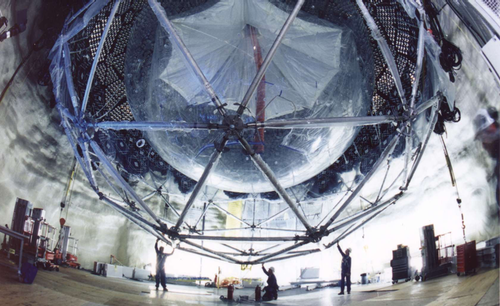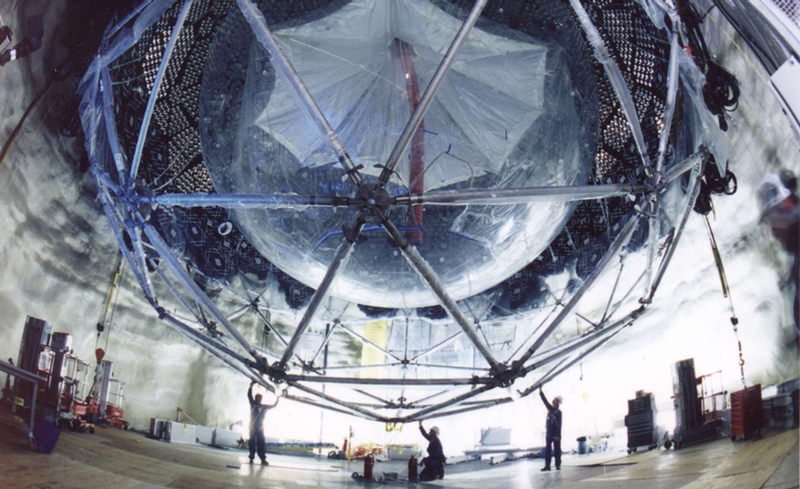Nobel Prize—Neutrinos Oscillate
The 2015 Nobel Prize in physics recognizes the discovery that neutrinos transform or “oscillate” among three different types. In a single stroke, it both solved a long-standing puzzle about these most elusive of fundamental particles and also exposed an incompleteness in the current bedrock theory of physics, called the standard model. The key findings behind the award were reported in three papers published in Physical Review Letters between 1998 and 2002.
Neutrinos are extremely hard to detect because they have very little mass, no electric charge, and only weak interactions with other fundamental particles. Yet they are, after photons, the second most abundant known particle in the Universe and are essential for understanding the nuclear reactions involved in fusion, which powers stars, and in radioactive beta decay.
Although it was not clear, even after they were first detected in 1956, whether neutrinos have any mass, the standard model, which describes all of the particles currently known, assumes that they do not. It also says that there are three types (“flavors”) of neutrino, called electron, muon, and tau neutrinos. Neutrinos produced in solar nuclear fusion were first detected in the late 1960s, and over the ensuing three decades, such measurements showed that there was a deficit of about 70% compared with the number of neutrinos predicted from calculations.
This shortfall of solar neutrinos was explained by experiments led by this year's laureates, Arthur McDonald of Queen’s University in Kingston, Canada, and Takaaki Kajita of the University of Tokyo. The work revealed that the three flavors of neutrino can interconvert as the particles stream through space. Thus, some electron neutrinos produced in the Sun become muon and tau neutrinos in transit—but the earlier detectors were not sensitive to these latter two flavors. The possibility of neutrino oscillations was first raised in 1957, but the Nobel-winning work demonstrated that such oscillations really do occur.
Kajita headed a team working at the Super-Kamiokande detector in Japan. The detector consists of a tank of 50,000 tons of water buried underground to shield it from cosmic rays. It detects electron and muon neutrinos coming not from the Sun but from the Earth’s atmosphere, where neutrinos are produced by collisions of cosmic rays with atmospheric atoms. Very rarely, these neutrinos will collide with atomic nuclei in the detector's water molecules and generate flashes of light.
Neutrinos interact so weakly with matter that they mostly pass straight through the Earth without disturbance, so Super-Kamiokande can detect neutrinos coming from any direction. In 1998, the researchers reported that they detected fewer muon neutrinos coming up through the Earth than coming down from above. This asymmetry suggested that some atmospheric muon neutrinos coming through the Earth had oscillated to (undetectable) tau neutrinos in transit, while those coming from above, having a far shorter path, had not had time to do so.
The experiment led by McDonald confirmed this conclusion in 2001 and 2002. It used a detector called the Sudbury Neutrino Observatory (SNO) inside a mine in Sudbury, Canada, containing 1000 tons of heavy water. In this case there were two types of collisions between neutrinos and heavy hydrogen (deuterium) atoms, one involving only electron neutrinos and the other involving all three flavors. So the relative amounts of the different flavors could be compared.
“The resolution of the solar neutrino flux was the major result,” says Frank Close, a particle physicist at the University of Oxford. “It was a problem that hung around for about 40 years.” He adds that SNO “would not exist in the way it does but for the persistence and energy of Art McDonald.”
In addition to explaining the solar neutrino deficit, these discoveries implied that neutrinos are not massless—according to theory, oscillations are only possible if there are differences in mass between the three flavors. It’s not yet known what these masses are, but they are very small, at least a million times less than the electron mass. And yet neutrinos are so numerous that they add up to a mass roughly equivalent to that of all the luminous matter in the Universe. Moreover, because the standard model is predicated on massless neutrinos, new theories will be required to explain why they have mass, so the discoveries of McDonald, Kajita, and their teams, point to future directions in physics research. Close says there are several current urgent questions regarding neutrinos, such as their potential connections with the mysterious dark matter and with the puzzling asymmetry between matter and antimatter.
–Philip Ball
Philip Ball is a freelance science writer in London. His latest book is How Life Works (Picador, 2024).
More Information
Neutrinos Have Mass—Focus story on the 1998 paper by Kajita and colleagues





